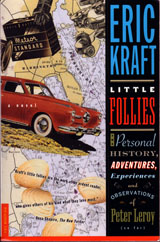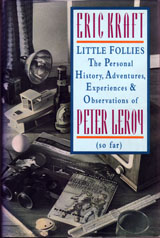

| Little Follies
Do Clams Bite? Chapter 6: Doomed |
by Eric
Kraft, as Peter
Leroy
|

YOU CAN READ THE FIRST HALF
YOU CAN ORDER THE
|
Big Grandfather was annoyed. He had wanted to get the boy out on the water; instead he was up in his room all the time making toys. Grandfather went out and bought the lumber for the first of the boats in the book, a flat-bottomed punt of the sort that one might pole in shallow waters. Overcompensating preposterously for my father’s miniaturism, he misread the scale in the drawings, and constructed, in the side yard, with my father as a conscripted apprentice, a twenty-foot punt, which, although singularly graceless, was ideally suited for cruising the shallow clam flats, since it drew very little water. It was not at all suited for crossing the bay to reach the flats, however. It bucked and reared over the smallest wavelets. As time passed, Grandfather added to the punt, which he christened the Rambunctious, bits and pieces of other boats in the book that caught his eye. There was a cabin from a trim little sloop, blown up in scale so that it almost seemed suitable. He added a large gaff-rigged sail from a catboat and a centerboard enlarged from the plans for a sailing dinghy. He began to feel a facility for improvisation, and so he undertook on his own the addition of a gasoline engine, an engine that had once powered a small tractor. The engine was never christened, but he was as surely male as the Rambunctious was female. The Rambunctious was always referred to as she, and the unnamed engine as he. Starting him, with a crank, occupied a good portion of the time spent in any of the Rambunctious’s excursions on the bay. Grandfather kept the Rambunctious in a slip on the estuarial stretch of the Bolotomy River, about half a mile upstream from the bay, where many other boats were docked. Most of those on the side where Grandfather kept the Rambunctious were working clamboats. On the other side of the river, broad lawns stretched out behind large, comfortable houses. Notched into each lawn was a slip, in some cases covered by a boathouse, that held a sloop or a mahogany runabout or both. Grandfather was a man of great patience and even temper; nothing better illustrated these qualities than his attempts to start him. Grandfather had intended that he would make the trip downriver to the bay quicker and easier than it was under sail, but it was not unusual for us to begin an outing in the early morning and be munching our lunch by the time we chugged past the town dock and reached the bay at last. While Grandfather patiently cranked and adjusted something and cranked again, I sat in the stern, dangling my legs overboard, playing a game with the undulating surface of the water. I tried to bring the soles of my bare feet as close to the surface as I could without touching it. It was a game that could not be won, a game that my father would have considered like my chasing kittens on the day that my mother tumbled from her lawn chair. I couldn’t win the game because I couldn’t know that I had reached the point I was after until I had passed it. To make matters worse, I included a forfeit in the game on this day: if I touched the surface ten times before Grandfather got him started, I would brave the clams. I would put some into the front of my bathing suit, just as Grandfather did, and take my chances on their biting. I had already failed nine times, and he showed no signs of starting. Grandfather had a series of procedures that he would follow, each of which was more severe than the last. He followed these procedures as predictably and precisely as if they had been regulations issued by the tractor manufacturer, printed on a little card that Grandfather had put in a black frame and screwed to the cabin bulkhead between his clamming license and the Rambunctious’s registration:
“Hit him with the crank handle!” I shouted. “Hey, take it easy,” said my father. “Hitting a machine never does any good. This isn’t something alive, you know, it’s a machine. You have to respect it. You shouldn’t ever take your anger out on a machine.” Grandfather snorted and whacked him a couple of good ones with the crank handle, then stuck the handle onto his crankshaft and spun it once. He coughed into life immediately, and Grandfather snorted again. A stone landed in the water near my feet, disturbing the surface of the water enough so that it hit my soles, too late, however, to require me to stuff clams into my bathing suit. I looked around and saw the boy who had interrupted my visit with Great-grandmother, the one she had called “rascal.” He was standing on the bulkhead, smiling at me. I smiled back and waved. When I saw him there, I saw also the possibility of having a friend, someone to hang around with. Seeing the possibility, I felt the need—for a boon companion, a roarer, a rowdy. I thought of asking Grandfather if the boy on the dock could come out clamming with us, but we were already past jumping distance from the dock, and Grandfather was never willing to turn back once one of these voyages was begun. I gave the boy another wave and watched him grow smaller as we chugged away. Behind the boy, two suntanned and leggy little girls, blond girls, so alike that I blinked and rubbed my eyes when I saw them, came walking into view, turning the corner from the street where Grandfather lived. They were wearing tiny white shorts and yellow halter tops. When they saw the rascal, they nudged each other and whispered. I knew at once what they were plotting; they were going to push him into the water. He was watching the Rambunctious, and they were so stealthy that he didn’t seem at all aware that they were sneaking up on him. I began making signs to warn him. I tried to be subtle, so that my gestures wouldn’t attract their attention. I cupped a hand and pointed my finger into it. That was supposed to mean “Look behind you.” He looked into his hand. I made a pushing motion with both hands. He looked at both his hands. I stood up on the stern and made the same motion. He repeated it. I made a much more exaggerated version of the shoving motion and then took the role of the victim, pantomiming losing my balance, waving my arms in a vain attempt to recover it, and falling into the water. “Peter!” shouted my father. “Hey, Dad! Stop! Peter fell in!” I was surprised, when I came up with a mouthful of water, to find that the water was sweet and clean. I looked across the river and noticed a small stream. The tide was going out, and I thought I could see the water from the stream flowing out on top of the receding mix of Bolotomy and bay water. It was smooth, soft, a coat of quicksilver poured over the gray-green and turbid water below it. I paddled around a bit, sampling the water from time to time. I heard applause, and found the rascal standing between the girls at the edge of the bulkhead, laughing and applauding me. I smiled and waved at them. “Peter! Grab hold!” called my father. He was holding a crab net out toward me. The Rambunctious was still chugging downriver, toward the bay, but Grandfather had throttled back so that she was barely moving. I knew that this was as close as he would come to turning back. “Maybe I should swim to shore,” I said, hoping that Grandfather would think that this was a good idea, since he would not have to interrupt his progress toward the flats, and the clams. “Don’t be ridiculous,” said my father. “Just take a couple of strokes, and you’ll be able to reach the net.” He was right. Reaching the net would be easy. I was able to imagine myself taking one, two, perhaps three strokes, and grabbing hold of the net. I was as easily able to imagine myself doing nothing. I could stop treading water and simply slip below the soft and silvery fresh water into the dark water of this stretch of the Bolotomy, fouled by so many boats. It was the darkness of that lower water and the certainty that the bottom would be a sticky ooze littered with rusting cans that made me decide against letting go. I began to take my strokes, and with each one I found myself repeating the question, “Do clams bite? Do clams bite? Do clams bite?” “There!” said my father. I had taken hold of the net without noticing, and he was pulling me alongside the Rambunctious. He helped me aboard and handed me a towel. I began drying myself. I saw the rascal standing on the dock between the girls, an arm around each of them. I wondered how that felt. He grinned suddenly, out of one side of his mouth, and the girls giggled. I felt doomed. |
 |
||||
| ..... | .......... | .......... | ..... |

Here are a couple of swell ideas from Eric Kraft's vivacious publicist, Candi Lee Manning: Tip the author.
Add yourself to our e-mailing list.
|
Little Follies is a work of fiction. The characters, incidents, dialogues, settings, and businesses portrayed in it are products of the author’s imagination and are not to be construed as real. Any resemblance to actual events or persons, living or dead, is entirely coincidental. All rights reserved. No part of this book may be reproduced or transmitted in any form or by any means, electronic or mechanical, including photocopying, recording, or by any information storage and retrieval system, without permission in writing from the author. “My Mother Takes a Tumble,” “Do Clams Bite?,” “Life on the Bolotomy,” “The Static of the Spheres,” “The Fox and the Clam,” “The Girl with the White Fur Muff,” “Take the Long Way Home,” and “Call Me Larry” were originally published in paperback by Apple-Wood Books. Little Follies was first published in hardcover by Crown Publishers, Inc., 201 East 50th Street, New York, New York 10022. Member of the Crown Publishing Group. YOU CAN ORDER THE
For information about publication rights outside the U. S. A., audio rights, serial rights, screen rights, and so on, e-mail the author’s imaginary agent, Alec “Nick” Rafter. The illustration at the top of the page is an adaptation of an illustration by Stewart Rouse that first appeared on the cover of the August 1931 issue of Modern Mechanics and Inventions. The boy at the controls of the aerocycle doesn’t particularly resemble Peter Leroy—except, perhaps, for the smile. |
|
||||||
| . | . |